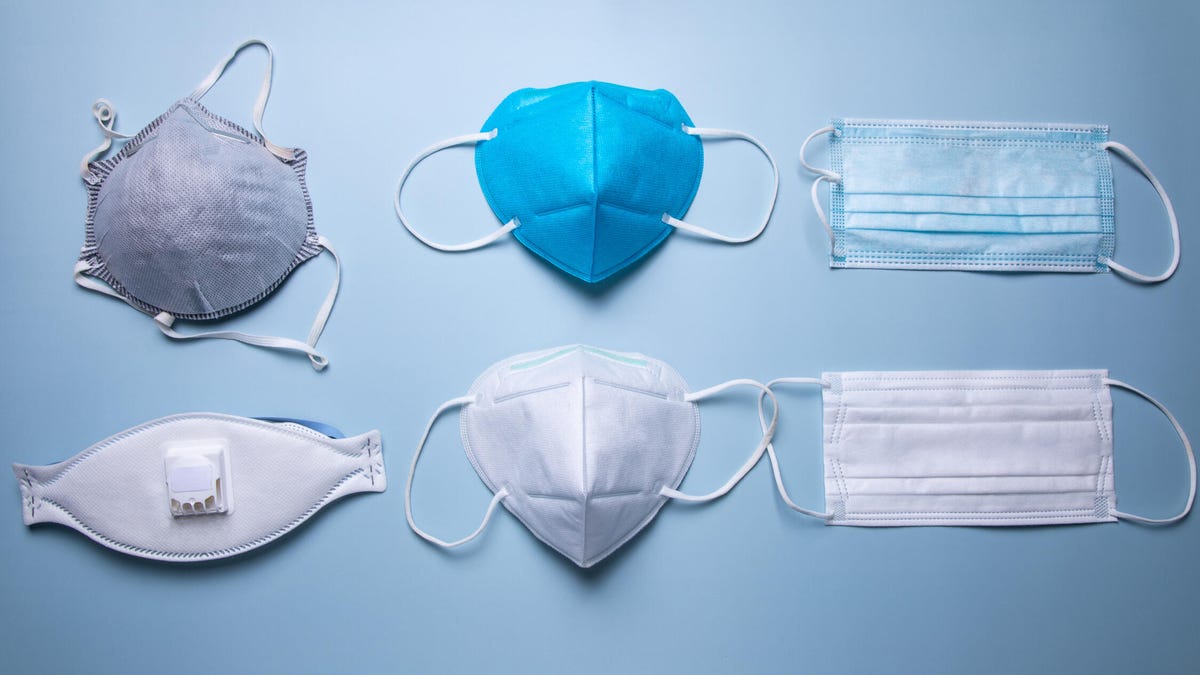Double masking for COVID-19: CDC recommends wearing two masks at once
Two masks are the new mask -- and we explain how to double mask properly.

Two masks are better than one. The new guidance for slowing the spread of COVID-19 is to double mask. First, Dr. Anthony Fauci endorsed it because "it just makes common sense," the chief medical adviser to the president told NBC News' Today. Now, the CDC recommends the same.
According to findings from a CDC study, wearing a cloth mask on top of a surgical mask helps improve the fit of the surgical mask. The closer-fitting the mask is your face, the fewer gaps there are between the mask and your face where respiratory droplets carrying the coronavirus can enter. The study found that, "The receiver's exposure was maximally reduced (>95%) when the source and receiver were fitted with modified medical procedure masks. These laboratory-based experiments highlight the importance of good fit to optimize mask performance."
Because layering masks reduces the porosity of your face covering, it's also more likely to do a better job of protecting you from those infectious respiratory droplets -- just like layering jackets protects you from the cold and just as an N95 (which is less porous) has a better shot at protecting you from environmental smoke, while a cloth mask (more porous) doesn't stand a chance.
It's not just about common sense, though. The concept of double masking is backed by some scientific studies, and no, wearing two masks won't suffocate you. Here's what to know about wearing two masks to slow the spread of COVID-19.
The science behind double masking
Layering masks might help reduce the transmission of infectious particles.
Dr. Fauci's recommendation comes in light of new strains of SARS-CoV-2, the coronavirus that causes COVID-19, that are thought to be more transmissible than the primary strain of SARS-CoV-2.
"With a more transmissible virus, that means every exposure has increased likelihood of leading to spread," says Andrea Love, an immunologist and microbiologist. "We must be more stringent with our behaviors now, including social distancing, minimizing trips to public places, avoiding indoor spaces and always wearing a mask."
"But, not just any mask will do," Love emphasizes. "Quality matters."
Masks work by trapping and blocking respiratory droplets that contain virus particles, Love explains. "The more physical barriers implemented, the more of these droplets you can block, thereby reducing the risk to yourself and others around you," she says. Ideally, the more layers the better, especially if you're wearing a thin cloth face cover. Even if you wear surgical masks, which generally have two thin layers already, you can still benefit from doubling up, Love says.
It's important to understand that cloth masks, like the ones worn routinely by most people, were intended to be a stopgap measure, Love says. Many cloth face covers offer little to no protection, she says, depending on the material, number of layers and fit, which is why health experts recommend layering.
In fact, three layers is really best: A recent (not yet peer-reviewed) study tested 11 mask materials and found that masks are more protective when they have three layers, two tightly woven cloth layers with a nonwoven, high-efficiency filter material sandwiched in between. If you don't already have a mask with three layers, you can mimic this by wearing a cloth mask and a surgical mask -- more about that is below.
When to wear two masks
If you're walking outdoors and aren't in proximity to people outside of your household, a single mask should suffice, Love says. If you plan to be near people who aren't in your household, however, even outdoors, "a simple solution is to double-mask."
Will wearing two masks make it hard to breathe?
Wearing two masks won't impede your oxygen flow.
Wearing two masks shouldn't make it any harder to breathe, Love says. Several studies have demonstrated that wearing masks doesn't impede oxygen consumption (even in adults over 65). "The size of an oxygen molecule is orders of magnitude smaller than the pore sizes of masks," Love says, but the problem is "many people don't realize the difference between discomfort and a true physiological effect."
Even with two face masks, you'll still be able to get the oxygen you need and dispel carbon dioxide from your body. Two masks might not feel comfortable at first, but it's still safe to wear them.
Sure, it may take some getting used to, especially if you wear two masks while exercising. You may get sweatier than usual as the weather warms up. But a little discomfort is a lot better than contracting COVID-19 or being responsible for spreading it.
How to properly double mask
If you have multiple cloth face covers at home, simply wear two.
Simply wearing one cloth mask on top of another might improve the protectiveness of your face covering, but a different combination may help more.
If you wear a cloth mask on top of a surgical mask, you can mimic the filter-cloth combo found to be more protective in studies. The surgical mask acts as a filter and the cloth mask provides an additional layer of protection while improving the fit, Love says. If your two masks fit well, this combination "should produce an overall efficiency of over 90% for particles 1 micron and larger, which corresponds to the average size of respiratory aerosols that are most important in mediating transmission of SARS-CoV-2."
Like Dr. Fauci told Today, "If you have a physical covering with one layer, you put another layer on, it just makes common sense that it likely would be more effective."

